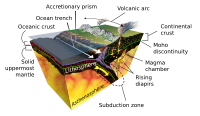
Photo from wikipedia
The subduction and close of the Mesozoic Bangong–Nujiang Ocean (BNO) led to a collision of the Lhasa and Qiangtang blocks, which formed the backbone of the Tibetan Plateau (the largest… Click to show full abstract
The subduction and close of the Mesozoic Bangong–Nujiang Ocean (BNO) led to a collision of the Lhasa and Qiangtang blocks, which formed the backbone of the Tibetan Plateau (the largest and highest plateau on Earth). However, the detailed subduction processes (in particular, the oceanic subduction processes) within the BNO are still not clear. Here, we focus on the plutonic complex of the oceanic arc in the Bangong–Nujiang suture (BNS) and report field observations on zircon U–Pb ages, Lu–Hf isotopes, and the Al-in-hornblende barometry of quartz diorites from the Lameila pluton in western Tibet. Zircon from the quartz diorites yielded a LA-ICP-MS U–Pb age of 164 Ma. The zircon showed very positive eHf(t) values from 10.5 to 13.9, suggesting the Lameila pluton was likely sourced from the depleted-mantle wedge, which is in contrast with contemporary (164–161 Ma) volcanic rocks in the region that had negative eHf(t) values of −7.4 to −16.2 and a magma source from partial melting of subducted sediments. The Lameila pluton showed a temperature-corrected Al-in-hornblende pressure of 3.9 ± 0.8 kbar, corresponding to an emplacement depth of 13 ± 3 km. Therefore, the thickness of the Jurassic oceanic arc crust must have doubled since the initial growth of the oceanic arc on the BNO crust, with a crustal thickness of 6.5 km during the Middle Jurassic. In combination with previous works on volcanic rocks, this study further supports a two-subduction zone model in association with the BNO during the Middle Jurassic, namely, a north-dipping BNO–Qiangtang subduction zone and an oceanic subduction zone within the BNO. The latter oceanic subduction zone produced the depleted-mantle-derived Lameila pluton and the subducted sediment-derived volcanic rocks in the fore arc.
Journal Title: Minerals
Year Published: 2019
Link to full text (if available)
Share on Social Media: Sign Up to like & get
recommendations!